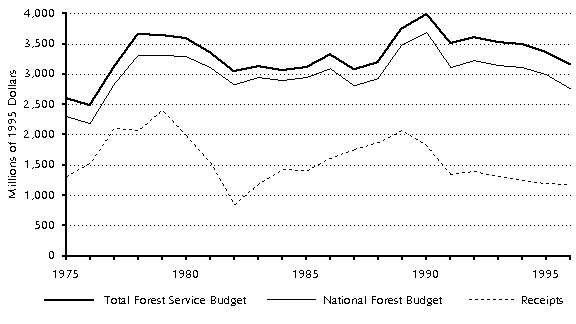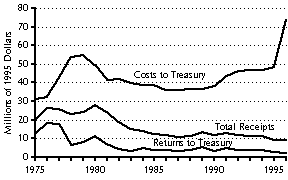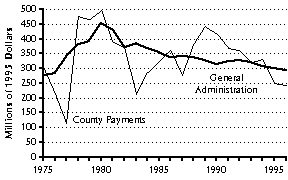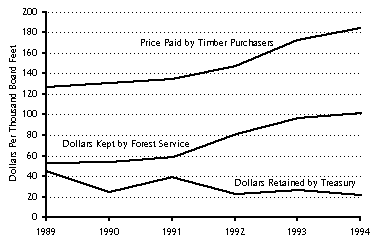Appearances are deceiving, however, and in fact the changes in the budget are all for show--they affect only the budget Congress sees, not the budget on the ground. On-the-ground managers will still have to keep track of spending in literally hundreds of different categories, and their flexibility to spend is not changed in the least. At best, for the on-the-ground manager, the new budget presents an opportunity to pull the wool over Congress' eyes and get more funding in a few areas where Congress thinks it is merely maintaining funding.
The Clinton budget makes no attempt at all to address the perverse incentives in the Forest Service budget--incentives that reward managers for losing money on environmentally destructive activities (see sidebar on page 14). Nearly all national forest controversies can be traced to these misincentives. By comparison with these problems, Clinton's reinvented budget is merely window-dressing.
This window-dressing consists of three basic changes:
Gains Losses Net W/ Planning
Recreation $23,800 $36,851 -$13,051 -$46,851
Wildlife & Fish 23,800 30,390 -6,590 -33,090
Range 10,030 9,873 157 -31,743
Timber Sales 42,004 6,866 35,138 3,338
Soils & Water 4,300 20,604 -16,304 -42,704
Minerals 12,540 5,496 7,044 5,344
Land 16,900 18,354 -1,454 -1,454
Fire 2,760 7,700 -4,940 -4,940
Transferring support dollars from the items giving support to the items
getting it results in major changes in apparent resource budgets. This table
also shows the new planning line item, detailed in table two. For example, this
table says that budget juggling transferred $33.1 million of what used to be
range dollars to other line items. So if the new range budget is $33.1 million
less than the old one, it is really unchanged.
Old Xfer to New Percent
Budget Planning Budget Reduction
Recreation $231,828 $33,800 $198,028 15%
Fish & Wildlife 135,277 26,500 108,777 20%
Range 49,371 31,900 17,471 65%
Timber Sales 173,744 31,800 141,944 18%
Soils & Water 94,515 26,400 68,115 28%
Minerals 35,311 1,700 33,611 5%
Five to 65 percent of resource management dollars had been spent on planning
activities, the Forest Service says. These dollars are now presented as a new
line item, "ecosystem planning, inventory, and monitoring," which results in
apparent reductions in resource funding. As this is just an accounting change,
actual resource budgets in most Forest Service offices will remain
unaffected.
All of these changes may seem logical in some sense or another. But they make it difficult to compare this year's budget with budgets from previous years. The comparisons made here are based on several adjustments which are partly approximations.
It is important to understand that these changes are only in the budget presented to Congress; they do not represent any differences in on-the-ground management. Planning, for example, has been a separate department in many national forest offices for years, funded by appropriations to other resources. The new budget merely acknowledges that reality.

One thing hasn't changed in the Forest Service's budget: It still spends a lot of money. The agency's total budget has run around $3.4 billion for the past several years. While it is declining slightly, most of that decline comes from a reduction in payments to counties. Recent appropriations out of tax dollars for national forests (including construction) have remained constant, or even increased slightly, at around $2 billion per year.
This is despite a huge decline in funding for timber sales. In 1991, the Forest Service spent $600 million on timber sales (including resource support and road construction) out of a total national forest budget of $2.0 billion from tax dollars. By 1994, the timber budget had fallen to around $450 million, but the total national forest budget had increased to more than $2.2 billion.
This means that the Forest Service spent over $350 million more on something else. Where did all this money go? Recreation, wildlife, range, and minerals each got little pieces of it. But the vast majority went straight into the fire--fire suppression, that is. Since 1994 was a "bad" fire year, the Forest Service spent nearly $300 million more on supression and protection than in 1991.
Another huge increase went to law enforcement, which more than tripled its budget in 1994. The Forest Service hadn't asked for this $40 million increase; it apparently received it as a "reward" for failing to detect timber thefts from the national forests.
For 1996, the administration's budget proposes a $200 million decrease in funding, mainly due to a hoped-for reduction in firefighting costs. National forest management costs are increased slightly, mainly due to range and recreation. Research remains about the same; state & private forestry is increased by about 10 percent; and construction falls by about 5 percent.

Before national forest timber sales started booming in the 1950s, fire was the Forest Service's big ticket item. Now that timber sales are on the wane, fire may once again become the main driving force within the agency. This will have dire consequences for federal spending, forest ecosystems, and possibly even the health of fire fighters.
Although fires never threatened more than a small percentage of American forests, they are so dramatic that Congress in 1908 gladly handed the Forest Service a blank check to put them out. Under the law, local forest managers confronted with a serious fire could declare an emergency and spend unlimited sums of money to put the fire out with the assurance that Congress would reimburse the funds spent at the end of the fire season.
The blank-check law helped reduce forest fires from more than 40 million acres per year in 1930 to an average of 5 million acres per year since 1960. But it also led to enormous waste and profligate spending during bad fire years. Fire fighters liked to say that the Forest Service put out fires by throwing money on them. They were also well aware that fires serious enough to be declared an emergency were also impossible to put out. For example, led by the Forest Service, the government spent $125 million trying to put out the 1988 Yellowstone fires--with little result until rain and snow put out the fires.
Even if the Forest Service couldn't stop the big fires, it could suppress most of the little ones. Decades of fire suppression had major ecological effects on the forests. Before the Forest Service, most American forests were burned every few years, either from natural causes or from fires started by Native Americans. By 1960, fire suppression in these forests led to significant changes in species composition and major epidemics of insects and disease. Fire suppression has ecologically devastated far more forest acres than clearcutting.
Because of the financial problems, Congress repealed the blank check law in 1980 and instead gave the Forest Service a flat sum for fire suppression each year. The agency could bank the money it saved during good fire years for use when fires were more serious. This also led the agency to change its tactics: It abandoned the rule that all fires should be "out by 10 o'clock" and contemplated letting fires burn in many areas.
This process seemed to work at first. The Forest Service reduced its spending on fire from a quarter of its national forest budget in the late 1970s to less than a sixth of its budget in the early 1980s. But then came the 1987 and 1988 fire seasons. The Yellowstone fire was just the tip of the flames engulfing America's forests, and the Forest Service not only spent all its fire suppression reserves but dipped deeply into the Knutson-Vandenberg fund to pay for fire fighters and equipment.
Forest managers might have learned a valuable lesson from those years: Don't waste money trying to put out fires you can't suppress. But Congress simply reimbursed the funds spent on fire fighting (which explains why the 1989 and 1990 fire budgets are so large) while it criticized the Park Service for not doing enough to put out the Yellowstone fires. The lesson this taught was, "If you waste money you will be a hero but if you save money you will be accused of destroying the forests." Today, well over a quarter of the national forest budget goes to fire.
In 1994, the Forest Service wasted lives along with dollars. A total of 33 forest fire fighters died, more than in any of the previous 50 years. An internal Forest Service report agreed with an investigation by the Occupational Health and Safety Administration in blaming 14 deaths from a Colorado fire on poor planning and communication.
The blame for economic waste, ecological destruction, and human lives lost can all be ultimately traced to the budgetary process. Even though the blank-check law is technically off the books, Congress and the Forest Service still act as though it remains in effect. Until Congress stops reimbursing the Forest Service's fire fighting costs, managers will continue to waste dollars, forest health will continue to decline, and fire fighters will continue to unnecessarily risk their lives.
The Clinton administration optimistically proposes a reduction in the 1996 fire budget. But so long as the Forest Service effectively has a blank check, actual spending will depend more on the weather than on Congressional appropriations. The fall, 1995, issue of Different Drummer will examine the relationship between fire, forest health, and timber salvage sales in more detail.

Since timber sales have fallen from a high of 12.4 billion board feet in 1980 to under 4 billion board feet in 1994, it is not surprising that the national forest timber budget has declined. But bureaucracies being what they are, neither is it surprising that the fall in the budget has failed to keep pace with the fall in sale levels. In fact, the two-thirds decline in sales is matched by less than a one-third decline in timber budgets.
Timber's share of the national forest budget--including timber roads and reforestation--has fallen from nearly 40 percent in the mid-1980s to under 15 percent today.
Back in 1985, the Forest Service spent about $50 for every thousand board feet offered for sale or cut. These costs, which include all sale costs and all road construction costs paid out of tax dollars, climbed slowly to nearly $60 per thousand in 1990. Then, due to the spotted owl, sales plummeted, but costs did not.
In 1990, when national forests offered 11 billion board feet for sale, timber sale costs (including resource support, salvage sales, and road construction) were about $640 million. Offerings were nearly halved in 1991, but the budget actually increased. By 1994, offerings were down to 3.4 billion board feet, but the budget for sales and roads was still $435 million. This brings average costs to well over $120 per thousand board feet--more than double 1990 costs even after adjusting for inflation.
Increasing timber sales costs are sometimes blamed on environmental assessments, appeals, and other planning requirements. But, according to TSPIRS, these costs average less than $7.50 per thousand board feet. Alternatively, the blame is placed on the cost of support from recreation, wildlife, and other resources. But timber sale support has actually declined faster than other costs.
The real problem, at least since 1990, is that the Forest Service has little incentive to insure that its costs are kept in line with its income. While some in Congress worry about the profitability of timber sales, they are overwhelmed by those worried about local jobs. And their response to reductions in timber sales is not to cut budgets but to beef up the agency's funding so it can get the cut out. While the Forest Service is reducing costs, it is doing so at a slow pace that allows staff to transfer into new jobs as budgets for other resources increase.
The agency expects to sell more timber--about 4.1 billion board feet--in 1995 at a lower total cost than in 1994. If this works out, its average costs will fall to $90 per thousand--still more than 50 percent more than in 1990. For 1996, costs will fall further but so, estimates the Forest Service, will timber sales, resulting in a slight increase in costs to $94 per thousand board feet.
Timber sale costs are increasing in another way as well. As recently as 1988, forest managers kept less than a third of timber receipts for their own budgets. By 1992, managers were keeping over half of all timber receipts. This year the percentage is expected to be close to 60.
One reason this has gone up is that the forests that returned most of the money to the Treasury were precisely those forests that have had the greatest reductions in timber sales. Managers are allowed to keep timber sale receipts only if they can spend them within the sale area. Where timber is very valuable, such as the spotted owl forests, managers can't find ways to spend all of the revenue in the sale area, so they return a larger share to the Treasury.

National forest grazing produces paltry revenues of about $10 million per year--only a quarter of which goes to the Treasury. Yet during the 1980s Congress gave the Forest Service $35 to $40 million per year for range management, boosting this to more than $45 million in the 1990s.
Agency managers are also allowed to keep 50 percent of the grazing fees they collect-- about $5 million per year. For this reason, if no other, the Forest Service would like to charge more for grazing. Although the law setting grazing fees at low levels expired in 1985, the issue is so politicized that the agency doesn't dare increase the fees. Fees set under the old formula have steadily declined because, notes the General Accounting Office, the formula double counts changes in the costs of producing livestock.
Forest plans showed that many national forests, particularly in Arizona and New Mexico, are overgrazed--that is, that grazing levels exceeded estimated grazing capacity. The Forest Service solution was always to spend more money to increase capacity, not to reduce use.
Even where managers agreed use should be reduced, they often stated that reductions could not be made until allotment management plans were revised. Yet allotment planning proceeds at a painfully slow pace.
The new budget transfers all range planning costs, or some $30 million per year, to the new planning line item. Meanwhile, the Forest Service wants to add some $25 million to the grazing budget to what is left of the range budget for "range restoration" that will "accelerate improvement in unsatisfactory range conditions."
As shown in the spring, 1994, issue of Different Drummer, such range "improvements" are almost always transitory in nature. Once the range is "improved," continuous injections of funds are needed to keep it in satisfactory condition. Increasing the range budget will just make ranches more dependent than ever on subsidies.
By an interesting coincidence, the injection of these new range improvement dollars would restore the total range budget to the same level (without adjusting for inflation) as it was before planning was taken out: about $45 million per year. This may not be a deliberate effort to deceive, but many people taking a quick glance think that the Forest Service is merely asking to maintain its grazing budget--when in fact it proposes increase it by more than 50 percent. If Congress approves this request, the total range budget (as historically defined) would be nearly $80 million per year--quite a lot for a resource that returns less than $3 million per year to the U.S. Treasury.

The Forest Service estimates that the market value of national forest recreation, exclusive of fish-and-wildlife recreation, is well over $2 billion per year, or far more than it has ever received for timber. But recreation doesn't make as good pork as timber, so the agency's recreation budget has always been smaller than its timber sales budget.
Recently, recreation seems to have pushed ahead of timber to become the largest item in the national forest budget other than fire and general administration. But this is deceptive for a number of reasons. Most importantly, the salvage sale budget has ballooned from under $35 million before 1988 to over $200 million in 1993. Before 1988, salvage sales accounted for less than 10 percent of the volume sold; now it is more like a third.
Salvage sale costs are a separate line item because they are funded out of other salvage sale receipts, not out of tax dollars. But when salvage sales and other timber-related costs are considered, it is clear that timber is still king.
Nevertheless, recreation budgets have increased significantly in recent years. But, after adjusting for all the changes since 1993--the transfer of some dollars to planning, the addition of trail maintenance, the adjustment for resource support, and inflation--the proposed 1996 recreation budget will be slightly smaller than in 1993.
On the ground, this translates to less trail maintenance: While the Forest Service proposes to do 2,600 more miles of trail maintenance outside of wilderness, it plans to do 5,300 fewer miles of trail maintenance inside of wilderness.
If Clinton doesn't favor wildlife & fish, he seems to like wildlife & fish managers. The wildlife & fish budget calls for 158 new full-time equivalents--a 26 percent increase over 1994. Wildlife & fish managers who want to actually improve habitat will have to continue to rely on K-V funds, giving them an incentive to support timber sales.
For 1996, the administration proposes to keep the timber road budget the same as in 1995 even though timber sales are projected to decline by 10 percent. The administration actually proposes a 15 percent increase in funding for recreation roads, though it is questionable whether recreationists need (that is, are willing to pay for) new roads on any of the national forests.
Thirty other forests that should begin planning in 1996 will be deferred "in order to complete ecosystem assessments." These assessments are akin to the regional plans of the last round of planning but are done along ecosystem boundaries instead of political ones. The assessment for one ecosystem, the Columbia Basin, will take several years at an average annual cost of $10 million. When all costs are considered, this round of forest planning will end up being more expensive as (but no better than) the last one.

This line item includes the salaries for line officers and their deputies; administrative activities; and services such as rent, utilities, and postage. Although counted as a national forest cost, it also covers research, state & private forestry, fire, construction, and land acquisition.
Measured as a percentage of the budgets for these other activities, general administration hovered between 15 and 20 percent from 1975 through 1989. Since then it has been slightly lower, mainly because of the large increase in fire fighting funds. For 1996, the agency proposes to reduce general administration from $299 million to $293 million.
That is all changed by the spotted owl plan, so Northwest counties convinced Congress to phase payments down--which means that they are higher, as a percentage of receipts, than 25 percent. In 1994, they reached 34 percent of the receipts out of which they are paid. But in 1995 this dropped to 27 percent, or around $250 million, where they are expected to remain in 1996.
This doesn't count "payments in lieu of taxes" or PILT funds, which are paid to counties on a per-acre basis according to a complicated formula that takes into account each county's population and deductions for payments out of the 25 percent fund. PILT is paid by the BLM for lands managed by the Forest Service, BLM, Park Service, Fish & Wildlife Service, and other federal agencies. PILT is considered a line item in the BLM's budget even though most of the money is attributable to other agencies.
The PILT formula is so complicated that the BLM claims that it doesn't know how much of the $100 million paid in 1994 was due to the Forest Service and how much was due to other federal agencies. The Forest Service's share was probably between $20 and $35 million.
In 1993, Congress voted to more than double PILT payments by 1999 from a maximum of 75cents per acre to $1.65 per acre. Since some 25 percent fund payments are deducted from PILT, this means that more counties won't even be getting 25 percent payments. As many as 90 forests earn less 25 percent funds than $1.65 per acre.

Cash payments for timber accounted for 84 percent of all national forest user fees in 1991. By 1995 this had fallen to 66 percent. More important, the share of receipts kept by the Forest Service has increased dramatically, from less than a third in 1988 to nearly 60 percent today.
This means that actual payments to the Treasury have fallen off considerably. From a high of $1.6 billion in 1976, Treasury receipts for national forest timber have dropped to less than $370 million today. After the counties take their 25 percent share (including a quarter of the Knutson-Vandenberg and salvage sale funds as well as road credits), the Treasury is left with under $200 million per year.
With such low receipts coming mainly from submarginal forests, it doesn't take many expenses for the national forest timber sale program to go into the red. Returns to the Treasury just barely cover the cost of timber sales, but don't come close to covering timber-related roads, reforestation, overhead, or other costs attributable to timber.
Meanwhile, the Forest Service estimates that the market value of recreation is more than $6.6 billion per year, including an estimated $2.7 billion for hunting and fishing. Hampered by Congressional restrictions against recreation fees and lack of incentives to collect any fees at all, Forest Service recreation receipts have averaged well under $50 million per year.
But in 1994, Congress allowed forest managers to keep 15 percent of recreation fees and to charge for a few more kinds of recreation. As a result, the Forest Service expects to increase recreation collections by 20 percent, to more than $60 million, in 1995. But the money is dedicated solely to collecting fees, so it won't give the agency an incentive to do much for recreationists other than send them bills.
Now its Congress' turn to try to change the agency. Unfortunately, Congress' history is no better than the administration's. Congress has repeatedly granted large shares of receipts to the Forest Service, counties, or others because doing so was easier than funding things out of tax dollars.
The new Congress should be open to new ideas that decentralize the forests and turn them into profit centers rather than black holes for tax dollars. But despite its conservative talk, the new Congress is leaning hard to micromanagement. The controversy over timber salvage suggests that Congress still thinks of forests as pork.
The basic problem hasn't changed from when the Democrats were in charge: The only members of Congress who have the time to really study the Forest Service are those with forests in their districts--and they inevitably tend to be commodity oriented.
When Congress approves the Forest Service's 1996 budget, then, it is not likely to be much better than Clinton's proposal. It may increase the budget for timber--particularly salvage sales. It may cut budgets for non-commodity resources. But real reform won't come until Congress gets serious about budget cutting. Even when it does, the reforms will do little good unless Congress takes the time to also understand incentives.